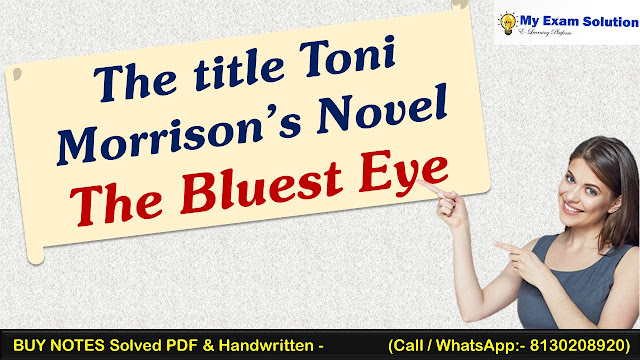Q. Discuss on the appropriateness of the title Toni Morrison’s novel The Bluest Eye
Introduction:
Discuss on the appropriateness of the title Toni Morrison’s novel The Bluest Eye Toni Morrison, born Chloe Ardelia Wofford on February 18,
1931, was an acclaimed American novelist, essayist, editor, and professor. She
is widely regarded as one of the most influential and celebrated authors of the
20th and 21st centuries. Morrison's works often explore complex themes such as
race, identity, memory, and the African American experience, delving into the
rich cultural heritage and historical struggles of black communities in
America. Discuss on the appropriateness of the title Toni Morrison’s novel The Bluest Eye
Toni Morrison's novel, "The Bluest Eye," published
in 1970, is a thought-provoking and emotionally intense work that delves into
the complexities of race, beauty, and identity. The title itself holds
significant meaning, which becomes apparent as we delve deeper into the
narrative. This essay aims to explore the appropriateness of the title
"The Bluest Eye" in relation to the central themes and characters of
the novel, while also drawing examples from the text to support our analysis.
The Connotations of the Color "Blue"
The color blue is often associated with melancholy, sadness,
and a sense of longing. In the context of the novel, the title "The Bluest
Eye" suggests a profound emotional yearning and a deep desire for
acceptance. The protagonist, Pecola Breedlove, is a young black girl growing up
in 1940s America, where societal beauty standards are dominated by whiteness.
Pecola's longing for blue eyes represents her yearning to be seen as beautiful
and desirable in a world that constantly belittles and marginalizes her because
of her race. Morrison effectively uses the color blue to convey a powerful
message about the damaging effects of internalized racism and the quest for
unattainable beauty standards.
The Quest for Beauty and Self-Worth
Throughout the novel,
the characters are deeply preoccupied with the concept of beauty and its
implications on their self-worth. Pecola's desire for blue eyes stems from her
belief that possessing them would validate her existence and transform her life
for the better. Morrison explores the destructive impact of such an aspiration,
highlighting the damage it inflicts upon Pecola's mental and emotional
well-being. By focusing on the pursuit of beauty through the lens of blue eyes,
Morrison critiques the superficial and harmful beauty standards perpetuated by
society, especially when it comes to race and ethnicity.
The Fragility of Innocence
The title "The Bluest Eye" also alludes to the
theme of innocence and its vulnerability in the face of societal prejudices.
Pecola is an innocent young girl whose desire for blue eyes is not merely about
physical appearance but is intricately linked to her longing for love,
acceptance, and belonging. As the story unfolds, we witness how the harsh
realities of racism and abuse shatter Pecola's innocence, leaving her
emotionally scarred and deeply wounded. Through this portrayal, Morrison
underscores the destructive impact of societal norms and attitudes on the
impressionable minds of children.
The Intersectionality of Race and Gender
Toni Morrison expertly weaves together the themes of race and
gender in "The Bluest Eye." The title, with its emphasis on
"eye," prompts us to consider how women, particularly black women,
are objectified and judged through the male gaze. The novel not only challenges
racial stereotypes but also delves into the oppressive ways in which black
women are subjugated, commodified, and devalued in a patriarchal society.
Morrison emphasizes the importance of understanding the unique struggles faced
by black women and the necessity of intersectionality in the fight against
societal injustices.
Conclusion
In conclusion, the title "The Bluest Eye" in Toni
Morrison's novel is highly appropriate as it encapsulates the central themes
and messages conveyed throughout the narrative. Through the color blue,
Morrison symbolizes a myriad of emotions and ideas, such as longing, sadness,
and the pursuit of unattainable ideals. The novel effectively critiques
society's damaging beauty standards, particularly in relation to race and
gender, and explores the devastating consequences of internalized racism and
self-hatred.
"The Bluest Eye" serves as a powerful reminder of
the importance of embracing one's unique identity and challenging societal
norms that perpetuate discrimination and injustice. Through the character of
Pecola Breedlove, Morrison urges readers to empathize with the marginalized and
advocate for a more inclusive and compassionate world.
By choosing this evocative and poignant title, Toni Morrison
successfully sets the tone for her novel and invites readers to reflect on the
profound messages hidden within the pages of "The Bluest Eye." The
novel remains a timeless classic, compelling us to confront uncomfortable
truths about the human experience and inspiring us to strive for a society that
celebrates diversity and nurtures the inherent beauty in each individual,
regardless of race or appearance.
The Bluest Eye Novel Summary
For PDF and Handwritten
WhatsApp – 8130208920
MA English or UGC NET Preparation







0 comments:
Note: Only a member of this blog may post a comment.